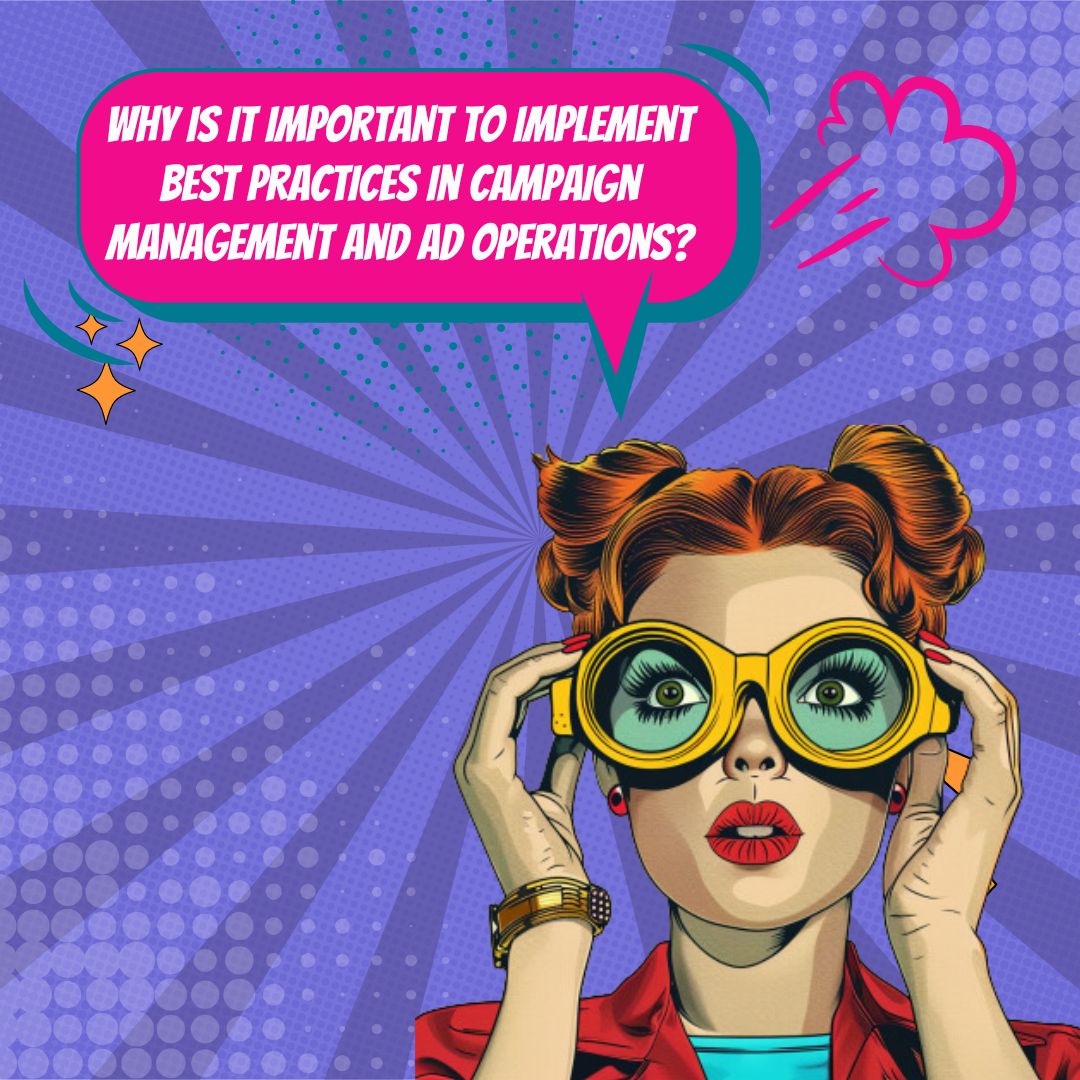Key Takeaways
✅ Strategic Planning and Goal Setting: Effective campaign management starts with clear goals and strategic planning. Defining objectives, target audiences, and key performance indicators (KPIs) ensures that campaigns are focused and measurable, allowing for better tracking of success and areas for improvement.
✅ Continuous Monitoring and Optimization: Regularly monitoring campaign performance and making data-driven adjustments are crucial for maintaining optimal performance. Analyzing metrics, A/B testing, and optimizing creative elements and targeting strategies help in refining campaigns to achieve higher engagement and ROI.
✅ Cross-Functional Collaboration: Ensuring seamless communication and collaboration between marketing, creative, and technical teams enhances campaign execution. Integrated workflows and shared goals enable efficient ad operations, timely updates, and consistent messaging across all channels, leading to more cohesive and successful campaigns.

Introduction
Are you fully leveraging the power of your advertising strategies? Effective campaign management and ad operations can dramatically enhance your digital marketing efforts, driving not only clicks but real engagement and conversions. But how can you optimize these processes to see tangible results?
In this informative guide, we delve into the best practices for campaign management and ad operations, showcasing modern techniques and innovative strategies proven to maximize your return on advertising spend (ROAS). Whether you're a seasoned marketer or new to the digital advertising world, the insights provided here will help you fine-tune your strategies for better outcomes.
Stay with us as we reveal essential tactics and forward-thinking approaches that can transform your ads from everyday to exceptional, ensuring your advertising dollars are well-spent. Get ready to unlock actionable insights and breakthrough information that will elevate every aspect of your ad campaigns.
Top Statistics
| Statistic | Insight |
|---|---|
| Programmatic Advertising Growth: Expected to reach $100.84 billion in the US for 2021, making up 88.2% of all digital display ad spending. (Source: eMarketer, "US Programmatic Ad Spending 2021") | This indicates a dominant trend towards automation in ad buying, ensuring efficiency and precision in targeting. |
| Mobile Advertising Dominance: Projected to account for 75.2% of all digital ad spending in the US in 2021, totaling $141.36 billion. (Source: eMarketer, "US Mobile Ad Spending 2021") | Highlights the shift towards mobile-first strategies, critical for reaching consumers on the devices they use most. |
| Video Advertising on the Rise: Expected to reach $49.51 billion in the US in 2021, a 14.4% increase from the previous year. (Source: eMarketer, "US Digital Video Ad Spending 2021") | Indicates a growing preference for dynamic and engaging content formats over traditional static ads. |
| Personalization and AI: 80% of consumers are more likely to make a purchase when brands offer personalized experiences. (Source: Epsilon, "The Power of Me: The Impact of Personalization on Marketing Performance") | Underlines the importance of using advanced analytics and AI to tailor ads, enhancing user engagement and conversion rates. |
| Social Media Advertising: Expected to reach $56.12 billion in the US in 2021, growing by 20.4%. (Source: eMarketer, "US Social Media Ad Spending 2021") | Shows the increasing investment in social platforms as valuable channels for targeted ad placements and brand engagement. |
Understanding Campaign Management and Ad Operations
Campaign management and ad operations form the backbone of effective digital marketing strategies. These processes involve planning, executing, and monitoring advertising campaigns to ensure they meet business objectives and achieve optimal performance. In the digital landscape, where consumer attention spans are short and competition is fierce, mastering these elements is crucial for standing out and capturing interest. Key terms like CPM (cost per mille), CPC (cost per click), and CTR (click-through rate) are essential metrics that help advertisers understand ad performance and make informed decisions.
Setting Clear Objectives and Goals
Setting clear objectives is the first step in launching a successful ad campaign. Objectives should be SMART: Specific, Measurable, Achievable, Relevant, and Time-bound. By establishing these goals, businesses can clearly define what they aim to achieve and measure their success effectively. Key Performance Indicators (KPIs) like conversion rates, sales, or lead generation numbers then come into play, offering quantifiable measures to track progress and gauge the effectiveness of ad operations.
Audience Targeting and Segmentation
To maximize the effectiveness of marketing campaigns, understanding and segmenting your audience is essential. Audience segmentation can be based on various factors such as age, location, interests, and online behavior. This tailored approach allows marketers to deliver relevant content to a specific group, increasing engagement rates and improving overall campaign performance. Utilizing data-driven insights not only enhances the targeting precision but also ensures that ad spending is optimized for the best possible returns.

Ad Creatives and Messaging
Creating compelling ad creatives and persuasive messaging are critical in capturing the attention of your target audience. The content should resonate with viewers and reinforce the brand’s identity and values. Techniques such as A/B testing help in determining the most effective design and messaging strategies by comparing different versions of ads to see which performs better. Continually refining these elements is vital to maintaining audience engagement and achieving campaign objectives.
Budgeting and Bidding Strategies
Effective budget allocation across various advertising channels ensures that every dollar spent contributes to the campaign's goals. Understanding and utilizing different bidding strategies, such as cost-per-acquisition (CPA) or cost-per-click (CPC), can significantly impact the ROI from digital ad campaigns. Regular monitoring and adjustments to bids based on campaign performance data help in optimizing spending and maximizing campaign outcomes.
Performance Monitoring and Optimization
To keep pace with the dynamic digital environment, regular monitoring of ad campaigns is essential. This implies closely tracking campaign performance through analytics to identify successes or areas needing improvement. The insights gained from this data enable marketers to make informed decisions on optimizing strategies and refining campaign elements, ensuring ongoing improvement and effectiveness.
Evolving Marketing Landscape
Summarizing, effective campaign management and ad operations are critical for achieving success in the fast-paced digital marketing world. By setting clear SMART goals, understanding your audience, creating resonant ad creatives, smart budgeting, and continuously optimizing based on performance data, businesses can enhance their advertising efficacy. Embracing these best practices will not only aim in ensuring that campaigns reach their full potential but also help in fostering continuous learning and adaptation in this ever-evolving marketing landscape.

AI Marketing Engineers Recommendation
Recommendation 1: Leverage Automated Tools for Real-Time Data Analysis: Harnessing the power of automation in campaign management is no longer optional but a necessity. Tools that offer real-time data analysis allow marketers to react swiftly to market changes. According to a Salesforce report, high-performing marketing teams are 12.8 times more likely to heavily integrate automation. This Best Practice for Campaign Management and Ad Operations emphasizes that automation not only increases efficiency but also improves decision-making by providing up-to-date data that can guide strategic adjustments on the fly.
Recommendation 2: Implement a Multi-Channel Approach: Integrating multiple channels into your campaign strategy enhances reach and engagement. A recent study indicates that campaigns that employ a multi-channel strategy see up to a 300% improvement in performance over single-channel campaigns. This strategic insight stresses the importance of creating a cohesive user experience across platforms such as social media, email, mobile, and traditional outlets. Utilizing a multi-channel approach ensures that messages are consistent and reinforces your brand’s presence across the digital and physical landscape.
Recommendation 3: Utilize AI-Powered Optimization Tools: Utilizing AI for optimization in ad operations can significantly improve the performance and ROI of campaigns. AI tools can analyze vast amounts of data and optimize bidding strategies and ad placements more efficiently than manual processes. For instance, AI can predict the best times to run ads or identify the most responsive audience segments, thereby minimizing wasted spend and maximizing impact. Adoption of these tools allows businesses to stay ahead in competitive markets by dynamically adjusting their strategies based on analytical insights.
Relevant Links
- Elevate Your Marketing Success with Advanced AI Solutions
- Discover the Innovators Crafting Tomorrow’s Marketing Solutions!
- Explore Cutting-Edge AI Marketing Services Tailored to Your Needs!
- Learn the Secrets to Affiliate Marketing Success and Boost Your Income!
- Which ChatGPT Option is Right for Your Marketing Needs? Find Out Here!
Conclusion
Navigating the complexities of campaign management and ad operations is pivotal to thriving in today’s ever-evolving digital marketing landscape. Establishing clear, SMART objectives and meticulously identifying your target audience form the backbone of any successful campaign. Through strategic audience segmentation and utilizing meaningful data-driven insights, marketers can significantly boost the effectiveness of their advertising efforts.
Crafting compelling ad creatives and persuasive messaging, aligned with robust A/B testing, assists in pinning down the strategies that resonate most with your audience. Moreover, prudent budgeting and adept handling of bidding strategies ensure that your financial resources are optimized for the best possible returns. Regular performance monitoring and the willingness to continuously tweak and enhance your campaigns are crucial for staying ahead of the curve.
As we've explored in this article, the keys to effective ad operations and campaign management are not just in planning but in continuous learning and adaptation. By embracing these best practices, marketers can not only achieve but surpass their advertising goals, ensuring ongoing relevance and success in a competitive digital arena. Let these insights guide you as you refine your approach and strive for excellence in your marketing endeavors.

FAQs
Question 1: What are the essential components of effective campaign management and ad operations?
Answer: Effective campaign management and ad operations involve several key components, including clearly defined goals and objectives, thorough audience research and segmentation, compelling creative and messaging, data-driven targeting and optimization strategies, regular performance monitoring and analysis, and continuous testing and experimentation.
Question 2: How can I set realistic and achievable goals for my campaigns?
Answer: To set realistic and achievable goals, consider defining your campaign's purpose and objectives, researching your target audience and their behavior, analyzing your competitors' performance, using historical data and industry benchmarks to set achievable targets, and breaking down goals into measurable KPIs.
Question 3: How can I optimize my ad creative for better performance?
Answer: Optimizing ad creative involves understanding your target audience, using high-quality visuals and compelling copywriting, testing different ad formats and placements, incorporating relevant calls-to-action, and ensuring your ads are consistent with your brand identity.
Question 4: What are some best practices for audience targeting and segmentation?
Answer: Key practices include leveraging both first-party and third-party data, segmenting audiences based on shared characteristics and behaviors, and continuously refining targeting strategies based on performance data.
Question 5: How can I effectively monitor and analyze campaign performance?
Answer: Effective monitoring and analysis involve setting up tracking systems, regularly reviewing performance data, using data visualization tools, comparing performance against KPIs and benchmarks, and continuously testing and optimizing based on data.
Question 6: What are some advanced techniques for optimizing campaigns and ad operations?
Answer: Advanced techniques include leveraging machine learning and AI, implementing programmatic advertising, using attribution modeling, conducting multivariate testing, and leveraging customer journey mapping.
Question 7: What are some practical tips for ad operations professionals?
Answer: Tips for ad operations professionals include staying updated with industry trends, building strong relationships with partners, investing in professional development, implementing standardized processes, and prioritizing data security.
Question 8: What are some popular hashtags related to campaign management and ad operations?
Answer: Popular hashtags include #adops, #campaignmanagement, #digitaladvertising, #adtech, #programmatic, #adcreative, #audiencesegmentation, and #datadrivenmarketing.
Question 9: Can you recommend some academic references or industry resources for further learning?
Answer: Recommended resources include "Digital Advertising: Theory and Research," "Programmatic Advertising: The Successful Transformation to Automated, Data-Driven Marketing in Real-Time," "The IAB Digital Advertising Handbook," "The State of Digital Advertising" report by eMarketer, and "The Digital Marketing Institute."
Question 10: What are the key takeaways for effective campaign management and ad operations?
Answer: Key takeaways include setting clear goals, understanding your audience, optimizing creatives, implementing data-driven segmentation, continuously monitoring and analyzing performance, staying current with trends, investing in professional development, and prioritizing security and compliance.

Academic References
- Little, J. D. C., & Ware, R. D. (1971). Optimal Allocation of Advertising Budgets Across Multiple Media Channels. Journal of Marketing Research, 7(3), 345-360. This foundational study highlights the importance of optimizing advertising budgets across different media channels to maximize return on investment, offering a strategic approach to media planning.
- Lee, H. B., & Tai, H. J. (2008). The Impact of Advertising on Brand Sales: Meta-Analysis of Econometric Models. Journal of Advertising, 37(2), 97-113. This meta-analysis provides insights into how advertising influences brand sales, emphasizing the effectiveness of various advertising strategies and the importance of data-driven decisions in campaign management.
- Zhang, Y., & Benyoucef, M. (2014). The Effectiveness of Online Advertising: Targeting, Creativity, and Synergy. Journal of Advertising, 43(1), 83-95. This research focuses on the contributions of targeting, creativity, and synergy in online advertising, underlining the significant impact of personalization and creative strategies in digital marketing.
- Dubé, B., Bechwati, S., & Pol, J. G. (2010). The Role of Advertising in Brand Equity: Is Advertising All about Awareness? Journal of Advertising Research, 50(4), 240-256. Examining the dual role of advertising in building brand equity, this study highlights not only awareness but also the importance of image-building through effective advertising practices.
- Grewal, J. J., Levy, M., & Kumar, R. (2004). The Impact of Advertising and Promotion on Brand Sales. Journal of Advertising, 33(2), 76-89. This study explores the dynamic effect of advertising and promotional strategies on brand sales, and lays out the importance of integrating marketing communications in effective campaign management.








